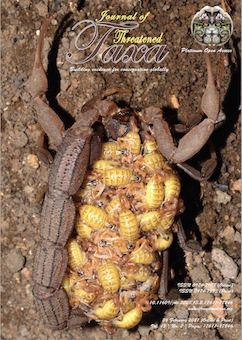Food habits of the Dusky-striped Squirrel Funambulus sublineatus (Mammalia: Rodentia: Sciuridae)
DOI:
https://doi.org/10.11609/jott.6202.13.2.17827-17831Keywords:
Funambulus sublineatus, Dusky–striped Squirrel, small mammal, feeding behaviour, Palani HillsAbstract
We report the first observations of feeding behaviour of the Dusky-striped Squirrel Funambulus sublineatus in the Western Ghats. It was observed feeding on eight plant species, including four non-native species. Feeding was observed in forests as well as in plantations and agricultural habitats, indicating the urgent need for studies in such human-modified landscapes.
References
Arasumani, M., D. Khan, A. Das, I. Lockwood, R. Stewart, R.A. Kiran, M. Muthukumar, M. Bunyan & V.V. Robin (2018). Not seeing the grass for the trees: timber plantations and agriculture shrink tropical montane grassland by two-thirds over four decades in the Palani Hills, a Western Ghats sky island. PLoS ONE 13(1): e0190003. https://doi.org/10.1371/journal.pone.0190003
Bali, A., A. Kumar & J. Krishnaswamy (2007). The mammalian communities in coffee plantations around a protected area in the Western Ghats, India. Biological Conservation 139(1–2): 93–102. https://doi.org/10.1016/j.biocon.2007.06.017
Borges, R.M. (1992). A nutritional analysis of foraging in the Malabar Giant Squirrel (Ratufa indica). Biological Journal of the Linnean Society 47(1): 1–21.
Champion, H.G. & S.K. Seth (1968). A revised survey of the forest types of India. Government of India Press, New Delhi, 404pp.
Datta, A. & R. Nandini (2014). Sciurids, pp. 534–535. In: Johnsingh A.J.T. & N. Manjrekar (eds.). Mammals of South Asia, Volume 2. University Press, Hyderabad, India.
Davidar, P., D.M. Dass & S.L. Vijayan (2007). Floristic inventory of woody plants in a tropical montane (shola) forest in the Palni hills of the Western Ghats, India. Tropical Ecology 48(1): 15–26.
Deng, X. B., P.Y. Ren, J.Y. Gao & Q.J. Li (2004). The Striped Squirrel (Tamiops swinhoei hainanus) as a nectar robber of ginger (Alpinia kwangsiensisy). Biotropica 36(4): 633–636. https://doi.org/10.1111/j.1744-7429.2004.tb00357.x
Deng, X., D. Mohandass, M. Katabuchi, A.C. Hughes & D.W. Roubik (2015). Impact of striped squirrel nectar-robbing behaviour on gender fitness in Alpinia roxburghii Sweet (Zingiberaceae). PloS ONE 10(12): e0144585. https://doi.org/10.1371/journal.pone.0144585
Dissanayake, R. & T. Oshida (2012). The systematics of the Dusky Striped Squirrel, Funambulus sublineatus (Waterhouse, 1838) (Rodentia: Sciuridae) and its relationships to Layard’s Squirrel, Funambulus layardi Blyth, 1849. Journal of Natural History 46(1–2): 91–116. https://doi.org/10.1080/00222933.2011.626126
Ganesh, T. & M.S. Devy (2006). Interactions between non-flying mammals and flowers of Cullenia exarillata Robyns (Bombacaceae), a canopy tree from the wet forests of Western Ghats, India. Current Science 90(12): 1674–1679.
Kellner, K.F., J.E. Duchamp & R.K. Swihart (2019). Niche breadth and vertebrate sensitivity to habitat modification: signals from multiple taxa across replicated landscapes. Biodiversity and Conservation 28(10): 2647–2667. https://doi.org/10.1007/s10531-019-01785-w
Matthew, K.M. (1962). The flora of Kodaikanal. Nelumbo 4(1–4): 95–104. https://doi.org/10.20324/nelumbo%2Fv4%2F1962%2F76481
Menon, V. (2014). Indian Mammals: A Field Guide. Hachette India, India, 386pp.
Myers, N., R. A. Mittermeier, C.G. Mittermeier, G.A. Da Fonseca & J. Kent (2000). Biodiversity hotspots for conservation priorities. Nature 403(6772): 853–858.
Nandini, R. & N. Parthasarathy (2008). Food habits of the Indian Giant Flying Squirrel (Petaurista philippensis) in a rain forest fragment, Western Ghats. Journal of Mammalogy 89(6): 1550–1556. https://doi.org/10.1644/08-MAMM-A-063.1
Paschoal, M. & M. Galetti (1995). Seasonal food use by the neotropical squirrel Sciurus ingrami in southeastern Brazil. Biotropica 27(2): 268–273. https://doi.org/10.2307/2389006
Rajamani, N., S. Molur & P.O. Nameer (2008). Funambulus sublineatus. The IUCN Red List of Threatened Species.e.T8703A12926423. Downloaded on 15 May 2020. https://doi.org/10.2305%2FIUCN.UK.2008.RLTS.T8703A12926423.en
Robin, V.V. & R. Nandini (2012). Shola habitats on sky islands: status of research on montane forests and grasslands in southern India. Current Science 103(12): 1427–1437.
Sidhu, S., T.R.S. Raman & D. Mudappa (2015). Prey abundance and leopard diet in a plantation and rainforest landscape, Anamalai Hills, Western Ghats. Current Science 109(2): 323–330. https://www.currentscience.ac.in/Volumes/109/02/0323.pdf
Sridhar, H., T.R.S. Raman & D. Mudappa (2008). Mammal persistence and abundance in tropical rainforest remnants in the southern Western Ghats, India. Current Science 94(6): 748–757.
Sushma, H.S. & M. Singh (2006). Resource partitioning and interspecific interactions among sympatric rain forest arboreal mammals of the Western Ghats, India. Behavioral Ecology 17(3): 479–490. https://doi.org/10.1093/beheco/arj058
Vivek, R., P.R. Agarwal & R. Sreekar (2011). Dusky Striped Squirrel Funambulus sublineatus as a part of mixed–species bird flocks. Indian BIRDS 7(2): 51.
Downloads
Published
Versions
- 26-02-2021 (2)
- 26-02-2021 (1)
Issue
Section
License
Copyright (c) 2021 Palassery Suresh Aravind, George Joe, Ponnu Dhanesh, Rajamani Nandini

This work is licensed under a Creative Commons Attribution 4.0 International License.
Authors own the copyright to the articles published in JoTT. This is indicated explicitly in each publication. The authors grant permission to the publisher Wildlife Information Liaison Development (WILD) Society to publish the article in the Journal of Threatened Taxa. The authors recognize WILD as the original publisher, and to sell hard copies of the Journal and article to any buyer. JoTT is registered under the Creative Commons Attribution 4.0 International License (CC BY), which allows authors to retain copyright ownership. Under this license the authors allow anyone to download, cite, use the data, modify, reprint, copy and distribute provided the authors and source of publication are credited through appropriate citations (e.g., Son et al. (2016). Bats (Mammalia: Chiroptera) of the southeastern Truong Son Mountains, Quang Ngai Province, Vietnam. Journal of Threatened Taxa 8(7): 8953–8969. https://doi.org/10.11609/jott.2785.8.7.8953-8969). Users of the data do not require specific permission from the authors or the publisher.
Funding data
-
Department of Science and Technology, Ministry of Science and Technology, India,Science and Engineering Research Board
Grant numbers ECR/2016/0020411





